
by Laura Tiu | Dec 2, 2021

Florida Master Naturalist Student and Florida State Park Ranger, Bruce Williams, prepares for his snowy plover lesson.
There is an oft quoted proverb “those who can’t do, teach.” It is meant to be humorous, but it couldn’t be farther from the truth. Teachers of all kinds have enormous impacts on our lives. For graduates of the Florida Master Naturalist Program (FMNP) there is a line in the mission statement that reads “The FMNP teaches those who teach others about Florida’s unique ecosystems and wildlife.” In fact, to graduate, FMNP students must complete a project and present, or teach, it to the class.
A good teacher, like a good entertainer first must hold his audience’s attention, then he can teach his lesson (John Henrik Clarke). In a recent coastal class, we had the good fortune of having a State Park Ranger as a student. His job requires him to do interpretive education at the park, so he had quite a bit of experience under his belt. His project, a craft project involving the assembly of a cute snowy plover chick, was his way of holding his audience’s attention while he talked of the importance of preserving and protecting habitat for shorebirds.
I thought the project and message was impressive and worthy of sharing. To all of you teachers out there who work to make our lives and world better, thank you, and here is another great activity to add to your quiver. If you would like more information on the Florida Master Naturalist Program go here: https://masternaturalist.ifas.ufl.edu.
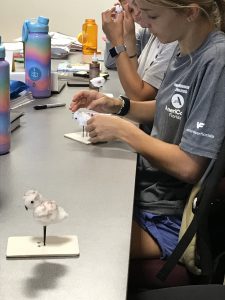
Making cotton ball snowy plover chicks
Group Project: Make a Snowy Plover Chick (Peipert, 2011)
This project is suitable for Elementary age through Middle school age children. It is recommended when doing project with a class or large group that some preparation is done ahead of time.
Supplies:
corrugated cardboard (disassembled brown packing box will do)
1 bag of cotton balls
1 container of black glass beads (sold at craft stores)
black sunflower seeds
1 container of wood toothpicks (kind with one end blunt)
1 can of black spray paint
several of each black, brown & gray markers
several bottles of quick dry tacky glue (sold at craft stores)
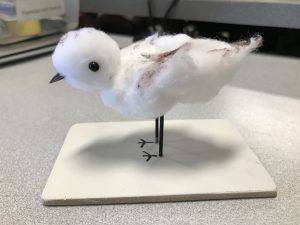
Cotton ball snowy plover chick craft
Preparation:
- Using an exacto or carpet knife and T-square cut corrugated cardboard into 3”x3” squares for the # of stands needed. To complete stand preparation, write Snowy Plover chick on stand, draw a pair of feet in center of stand and pierce cardboard in center of feet. This step is a real time saver and recommended for young children.
- Paint toothpicks with black spray paint for legs, easiest way to do this is by taking toothpicks and sticking them into a spare piece of cardboard upright them paint.
Instructions: (skip to instruction #3 if using stands with feet & holes premade)
- Draw a pair of bird feet on center of cardboard and if you want write” Snowy Plover chick” on cardboard.
- Use the pointed end of a toothpick to make a hole in the center of drawn feet. Then put the blunt end of toothpicks in the holes and put a heavy glob of glue around them. Don’t be shy with the glue, it will dry clear and will be better support.
- Take one of the cotton balls and roll around between hands to make it smaller. This will be the head. Next using all three or two markers make many dots on one side of both cotton balls creating a speckled pattern.
- Put a glob of glue at top of each toothpick and put larger cotton ball (the body) on top of toothpicks pushing down so the glue is covered by the cotton ball. Next put a glob of glue on the top of body and put white side of cotton ball (the head) on glue.
- To complete the chick put a small glob of glue on opposite sides of head then place glass beads on. Lastly put a glob of glue on side of head that the feet are facing forward and place sunflower seed on with the pointed end facing out.
- Let stand for at least 15 minutes to dry before handling.
- Enjoy your Snowy Plover chick creation!

by Laura Tiu | Sep 9, 2021

A Lionfish Removal and Awareness Day festival volunteer sorts lionfish for weighing. (L. Tiu)
The northwest Florida area has been identified as having the highest concentration of invasive lionfish in the world. Lionfish pose a significant threat to our native wildlife and habitat with spearfishing the primary means of control. Lionfish tournaments are one way to increase harvest of these invaders and help keep populations down. Not only that, but lionfish are a delicious tasting fish and tournaments help supply the local seafood markets with this unique offering.
Since 2019, Destin, Florida has been the site of the Emerald Coast Open (ECO), the largest lionfish tournament in the world, hosted by Destin-Fort Walton Beach and the Florida Fish and Wildlife Commission (FWC). While the tournament was canceled in 2020, due to the pandemic, the 2021 tournament and the Lionfish Removal and Awareness Day festival returned to the Destin Harbor May 14-16 with over 145 tournament participants from around Florida, the US, and even Canada. The windy weekend facilitated some sporty conditions keeping boats and teams from maximizing their time on the water, but ultimately 2,505 lionfish were removed during the pre-tournament and 7,745 lionfish were removed during the two-day event for a total of 10,250 invasive lionfish removed. Florida Sea Grant and FWC recruited over 50 volunteers from organizations such as Reef Environmental Education Foundation, Navarre Beach Marine Science Station and Tampa Bay Watch Discovery Center to man the tournament and surrounding festival.
Lionfish hunters competed for over $48,000 in cash prizes and $25,000 in gear prizes. Florida Man, a Destin-based dive charter on the DreadKnot, won $10,000 for harvesting the most lionfish, 1,371, in 2 days. Team Bottom Time secured the largest lionfish prize of $5,000 with a 17.32 inch fish. Team Into the Clouds wrapped up the $5,000 prize for smallest lionfish with a 1.61 inch fish, the smallest lionfish caught in Emerald Coast Open History.
It is never too early to start preparing for the 2022 tournament. For more information, visit EmeraldCoastOpen.com or Facebook.com/EmeraldCoastOpen. For information about Lionfish Removal and Awareness Day, visit FWCReefRangers.com
“An Equal Opportunity Institution”
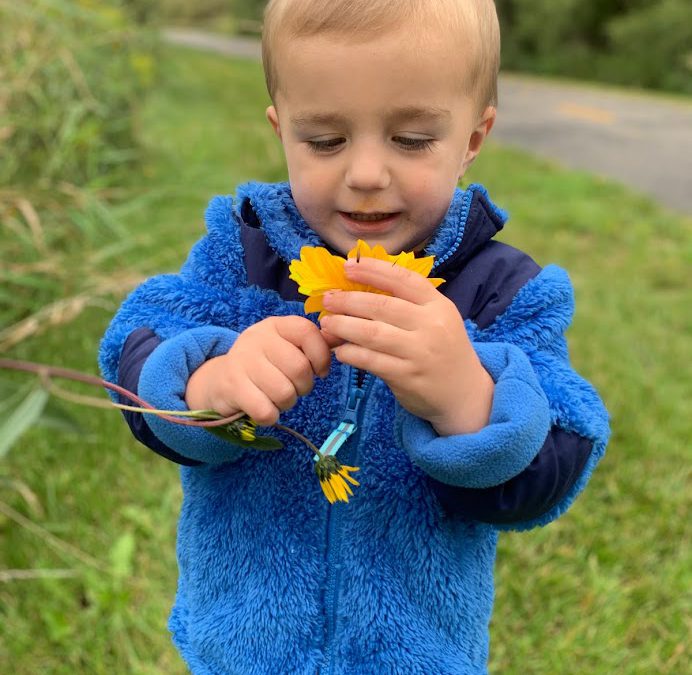
by Molly Jameson | Aug 12, 2021

Article by Rachel Mathes, Horticulture Program Assistant with UF/IFAS Extension Leon County.
By Rachel Mathes
My only brother and his family live in Appleton, Wisconsin. Though I’m only able to see my niece and nephews one or two times a year, we have a deep connection through our love of the outdoors.

Zach discovering the joy of nature. Photo by Rachel Mathes.
Their middle son, Zachary, is a budding naturalist at just four years old. When I visit them, Zach, his brother Connor, sister Cecilia, and I, load up the wagon and go for walks on the edge of the prairie in their neighborhood. We start our walks looking for scat and signs of wildlife. Because the kids are so close to the ground, they often spot wildlife trails before I do. We talk about what animals may be there, what they eat, and how we can help them.
After each walk, we wind down at home with an iNaturalist session. Zach and his siblings help me choose what animal or plant we think we saw with the help of the app’s nearby suggestions tool. A favorite game we play after all our photos are entered into the app is a game we’ve coined, “where’s that animal?” We use the iNaturalist explore feature to find sightings of exciting creatures like wolves and beavers near their home. The kids have learned that even scientists often don’t see the animals they study, just signs of them.
At age three, Zach learned to identify milkweed with impressive accuracy. I pointed out the plant on a previous trip more than six months earlier and he remembered how to find them. Common milkweed, Asclepias syriaca, is a large leafed species that prefers winters a bit colder than we get here in the Florida Panhandle, but is native in northern states across the Eastern US, including Wisconsin. Zach is often stopping the wagon to scout for monarch caterpillars, finding even the smallest instars and eggs.
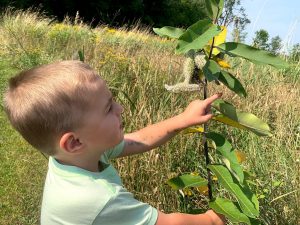
Zach learned to identify common milkweed, Asclepias syriaca, at the age of three. Photo by Rachel Mathes.
When I video call the kids from Florida, Zach is often asking to see my fruit trees, vines, and bushes. He knows that we have very different seasons than Wisconsin when I am eating blueberries in May and he’s still knocking frost off his snow boots. In July, he tells me about the raspberries they find in the woods with their dad. We both get a bit of seasonal berry jealousy. On my last trip we planted thornless blackberries in their garden together. It remains to be seen whether the birds will let the kids have a harvest, but the kids will be excited either way.
Though we may live a thousand miles apart, I know my relationship with my niece and nephews will continue to thrive as they explore the natural world around them. One day, I hope to introduce them to the awe of Florida manatees and alligators. Until then, I will relish the time we get to spend together outdoors in nature and on the phone together. I know that Zachary and his siblings will grow up having respect for the natural world and I hope he always exclaims, “Monarch! Look auntie Rachel, a monarch caterpillar!” on our walks together.
Author: Rachel Mathes, Horticulture Program Assistant with UF/IFAS Extension Leon County.

by Chris Verlinde | Mar 5, 2021
On most days, if you walk to the end of the Navarre Beach Fishing Pier, you will find a group of shark anglers that provide valuable data to the National Oceanic and Atmospheric Administration (NOAA) Cooperative Volunteer Shark Tagging program. Led by Earnie Polk, 50-60 team members have participated in the cooperative tagging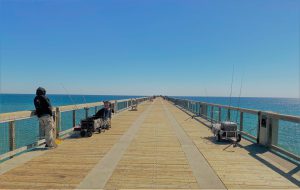 program in the twenty-five years he has been involved.
program in the twenty-five years he has been involved.
This group not only provides research data to NOAA, but are also stewards of pier etiquette, Navarre Beach and the surrounding area. Tourists and locals alike are treated to stories of local history, fish tales and general information about the area from Earnie and Team True Blue members. In addition, visitors may see a shark tagged and released or the group catching large fish to be used for shark bait

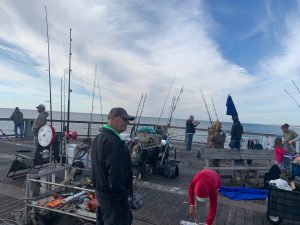
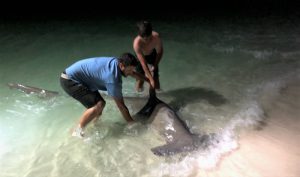
Photo Credit Earnie Polk
The NOAA Cooperative Shark Tagging program has been in existence since 1962. Today thousands of anglers along the Gulf of Mexico and Atlantic Coast have tagged more than 295,000 sharks representing 52 different species. More than 17,500 sharks have been recaptured! This program provides information on shark migration patterns, numbers, locations, migrations, age and growth rates, behavior and mortality.
Earnie estimates he has tagged more than one-thousand sharks for the program. He has refined handling methods to have the least impact on the animal to ensure the survival of the shark after release. The team brings the shark to shore to measure the length and tag the shark just behind the dorsal fin. 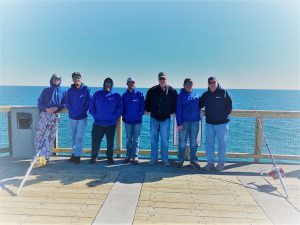
Earnie shared an interesting story about tagging at least eighty Dusky sharks during a red tide event during the late fall of 2015. He noticed as the north winds blew the red tide out, an open area was created along the coast. This allowed clear water for the sharks to travel closer to shore and within distance of the tag and release team.
Today, the tiger shark is the most common shark the team tags and releases. Recently, the team tagged and released a 12’6” tiger shark. Randy Meredith, of the Navarre Newspaper agreed to share the video he edited of the Navarre Fishing Pier and the tag and release of the tiger shark in February 2021.
 The team uses heavy gear, 200-pound test line and Everol reels that have drag pressure for a shorter fight to reduce stress on the animal for a better survival rate. Gear is spread along the rails at the end of the pier. Baited lines range from approximately 75 to 400 yards off the end of the pier. You probably wonder how they get their line 400 yards off the pier. Earnie has modified a fiberglass kayak with a battery powered motor. It is lowered to the surface of the water; team members drop their lines onto the kayak and Earnie pilots the kayak out to deeper water.
The team uses heavy gear, 200-pound test line and Everol reels that have drag pressure for a shorter fight to reduce stress on the animal for a better survival rate. Gear is spread along the rails at the end of the pier. Baited lines range from approximately 75 to 400 yards off the end of the pier. You probably wonder how they get their line 400 yards off the pier. Earnie has modified a fiberglass kayak with a battery powered motor. It is lowered to the surface of the water; team members drop their lines onto the kayak and Earnie pilots the kayak out to deeper water. 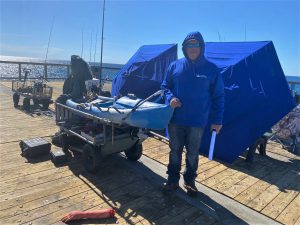
Their strategy is that by dropping more lines, at different depths and locations a shark is bound to trip over one of the lines. They use bait they catch on the pier or other fishing trips. Something big had hit on a cow nose ray over the weekend, so most members were using rays for bait. One team member said, “if the fish had hit on a watermelon, we all would be using watermelon for bait.” These guys have a great sense of humor!!
Make sure that the next time you visit Navarre Beach, you take time to walk out to the end of the fishing pier to learn about local sharks,  history and the area from these interesting, funny and helpful anglers. On clear days you may see sharks, rays, sea turtles and other types of marine life as you venture out.
history and the area from these interesting, funny and helpful anglers. On clear days you may see sharks, rays, sea turtles and other types of marine life as you venture out.
Be sure to stop at the pier store to pay the $1.00 per-person fee to enjoy the view!
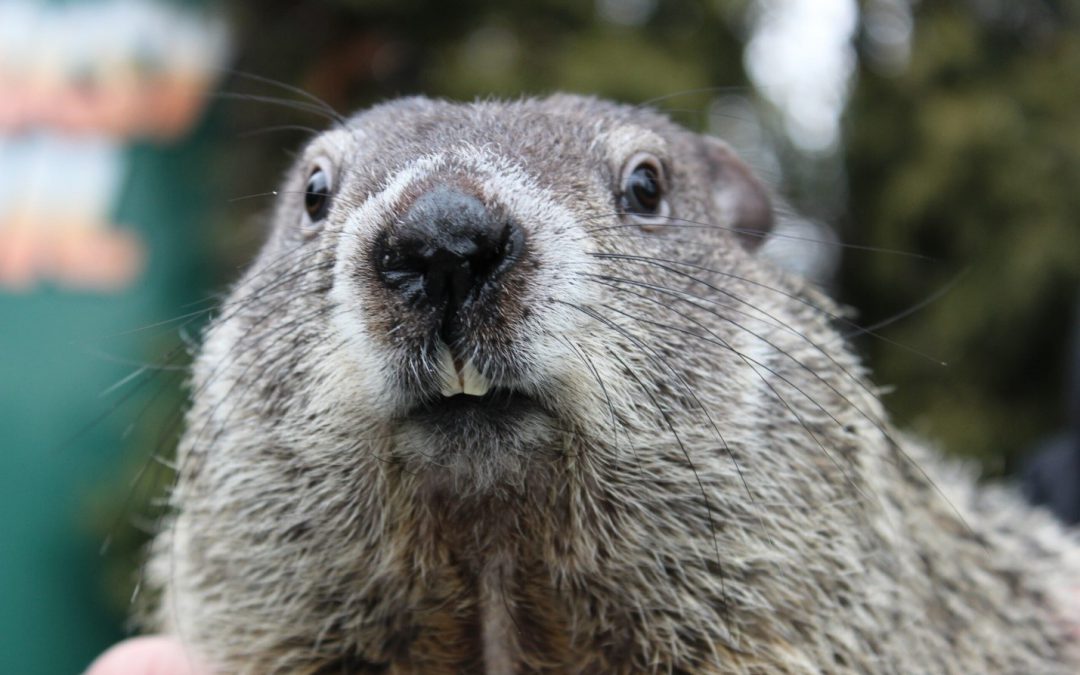
by Sheila Dunning | Jan 28, 2021
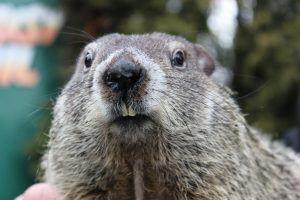
Groundhog
Groundhog Day is celebrated every year on February 2, and in 2021, it falls on Tuesday. It’s a day when townsfolk in Punxsutawney, Pennsylvania, gather in Gobbler’s Knob to watch as an unsuspecting furry marmot is plucked from his burrow to predict the weather for the rest of the winter. If Phil does see his shadow (meaning the Sun is shining), winter will not end early, and we’ll have another 6 weeks left of it. If Phil doesn’t see his shadow (cloudy) we’ll have an early spring. Since Punxsutawney Phil first began prognosticating the weather back in 1887, he has predicted an early end to winter
only 18 times. However, his accuracy rate is only 39%. In the south, we call also defer to General Beauregard Lee in Atlanta, Georgia or Pardon Me Pete in Tampa, Florida.
But, what is a groundhog? Are gophers and groundhogs the same animal? Despite their similar appearances and burrowing habits, groundhogs and gophers don’t have a whole lot in common—they don’t even belong to the same family. For example, gophers belong to the family Geomyidae, a group that includes pocket gophers, kangaroo rats, and pocket mice. Groundhogs, meanwhile, are members of the Sciuridae (meaning shadow-tail) family and belong to the genus Marmota. Marmots are diurnal ground squirrels. There are 15 species of marmot, and groundhogs are one of them.
Science aside, there are plenty of other visible differences between the two animals. Gophers, for example, have hairless tails, protruding yellow or brownish teeth, and fur-lined cheek pockets for storing food—all traits that make them different from groundhogs. The feet of gophers are often pink, while groundhogs have brown or black feet. And while the tiny gopher tends to weigh around two or so pounds, groundhogs can grow to around 13 pounds.
While both types of rodent eat mostly vegetation, gophers prefer roots and tubers while groundhogs like vegetation and fruits. This means that the former animals rarely emerge from their burrows, while the latter are more commonly seen out and about. In the spring, gophers make what is called eskers, or winding mounds of soil. The southeastern pocket gopher, Geomys pinetis, is also known as the sandy-mounder in Florida.
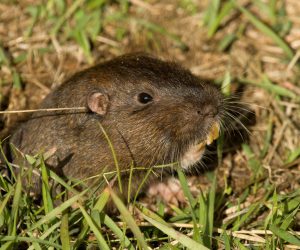
Southeastern Pocket Gopher
The southeastern pocket gopher is tan to gray-brown in color. The feet and naked tail are light colored. The southeastern pocket gopher requires deep, well-drained sandy soils. It is most abundant in longleaf pine/turkey oak sandhill habitats, but it is also found in coastal strand, sand pine scrub, and upland hammock habitats.
Gophers dig extensive tunnel systems and are rarely seen on the surface. The average tunnel length is 145 feet (44 m) and at least one tunnel was followed for 525 feet (159 m). The soil gophers remove while digging their tunnels is pushed to the surface to form the characteristic rows of sand mounds. Mound building seems to be more intense during the cooler months, especially spring and fall, and slower in the summer. In the spring, pocket gophers push up 1-3 mounds per day. Based on mound construction, gophers seem to be more active at night and around dusk and dawn, but they may be active at any time of day.
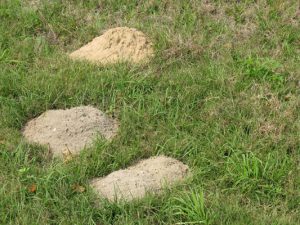
Pocket Gopher Mounds
Many amphibians and reptiles use pocket gopher mounds as homes, including Florida’s unique mole skinks. The pocket gopher tunnels themselves serve as habitat for many unique invertebrates found nowhere else.
So, groundhogs for guesses on the arrival of spring. But, when the pocket gophers are making lots of mounds, spring is truly here. Happy Groundhog’s Day.

by Pat Williams | Oct 16, 2020
Pat is the County Extension Director and the Agriculture/Horticulture/Natural Resources agent for UF/IFAS Extension Wakulla County while also serving as the Master Gardener Volunteer Coordinator for both Franklin and Wakulla counties.
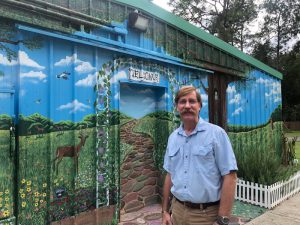
Pat by their outdoor mural at the Extension office.
He earned his doctorate from Texas A&M University in horticulture, a M.S. degree from Kansas State University in horticultural therapy, a B.S. degree in ornamental horticulture/floriculture from Cal Poly San Luis Obispo and an A.S. degree in ornamental horticulture from Crafton Hills College.
Over his horticulture career that started at age 13 working for Chrysanthemum Gardens in Crestline, CA, he has resided in 10 different states with a wide range of environmental influences (CA, KS, NJ, ME, NY, WA, TX, KY, TN and FL). He has held various positions in his career from teaching adults with developmental disabilities in NJ and ME, designing, installing and maintaining landscapes, landscape construction, being a horticultural therapist in New York City, working for the USDA in WA, teaching in a TX federal prison for his Extension appointment, teaching horticulture in a TN high school and was an university horticulture professor for 14 years in KY after teaching at Kansas State University, Washington State University and Texas A&M University as a teaching assistant. He started with the University of Florida/Institute of Food and Agricultural Sciences in April 2017 as the Sarasota County Residential Horticulture Agent/Master Gardener Volunteer Coordinator and transitioned to the Wakulla County Extension office in June 2020.
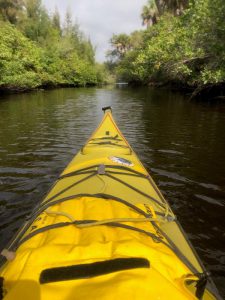
Kayaking the Myakka River, FL.
Teaching and greenhouse growing are his professional joys. Florida is the first state where there has not been a greenhouse to play in and he misses it greatly, however Extension does offer many opportunities to share his passion for plants and outdoors with a new group of learners. Otherwise Pat grew up on the beaches and ski resort areas of southern CA and still finds solace today relaxing on the beach or kayaking. He has traveled a bit visiting 49 states with only Hawaii to go. When indoors he would rather be baking or cooking in the kitchen as his second career choice would have been a chef. There is usually a yard full of flowers, herbs and vegetables and he is an extremely proud FSU Seminole Dad to Tara, a 2020 graduate.
Pat wears many hats at the Wakulla office and handles topics other than 4-H Youth Development or Family and Consumer Sciences. Once again he finds himself in a transition adapting to the new horticultural environment of Florida’s panhandle and developing more programs in agriculture and natural resources. Please feel free to reach out to see how the UF/IFAS Extension Wakulla County can be of assistance.


























